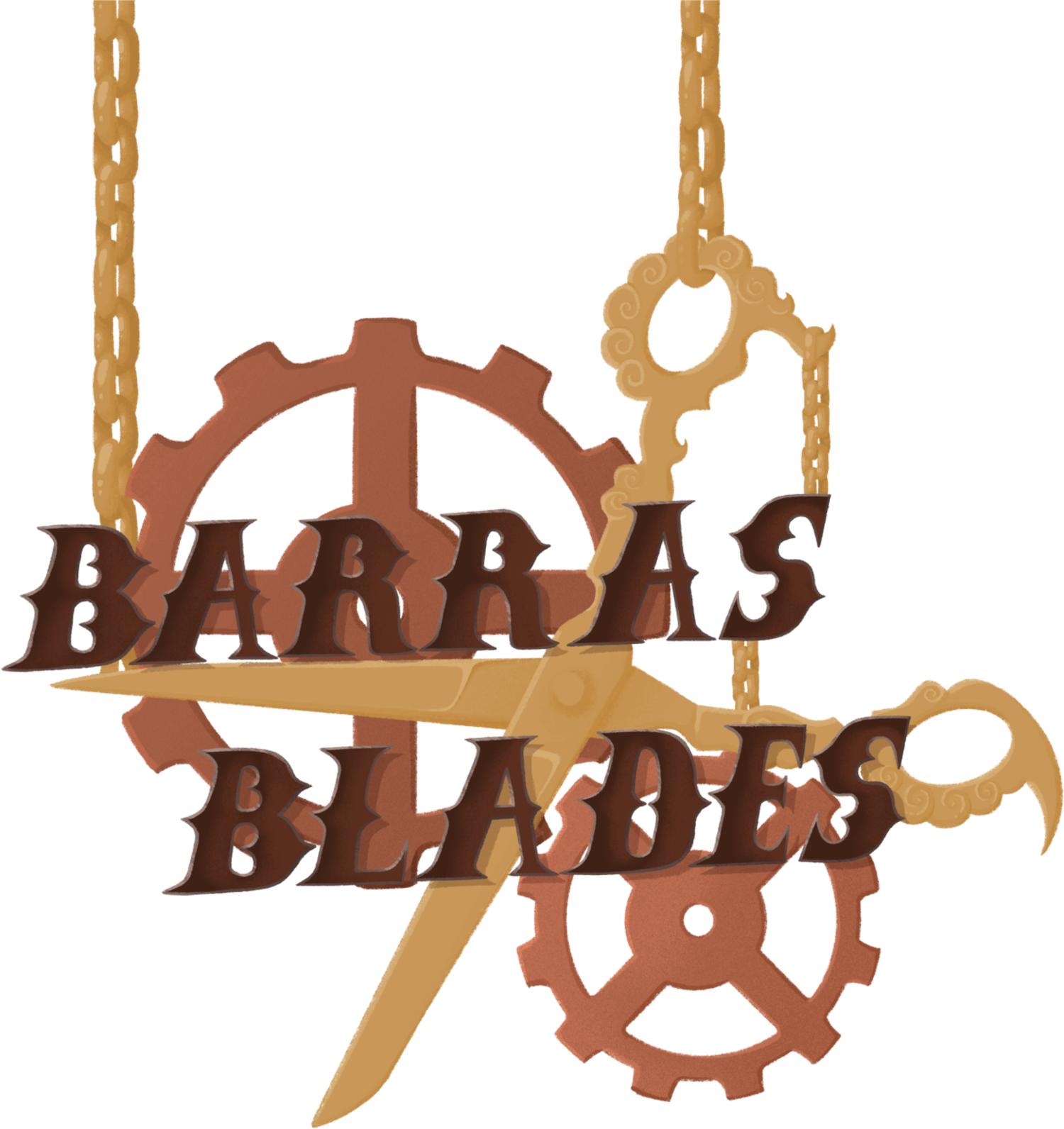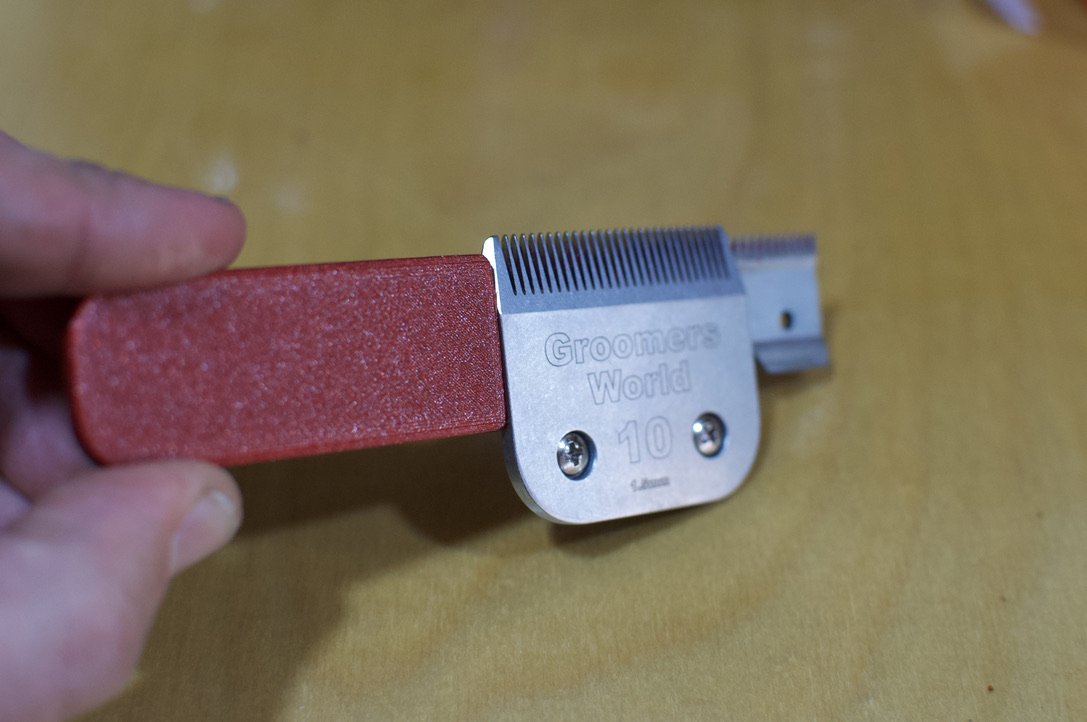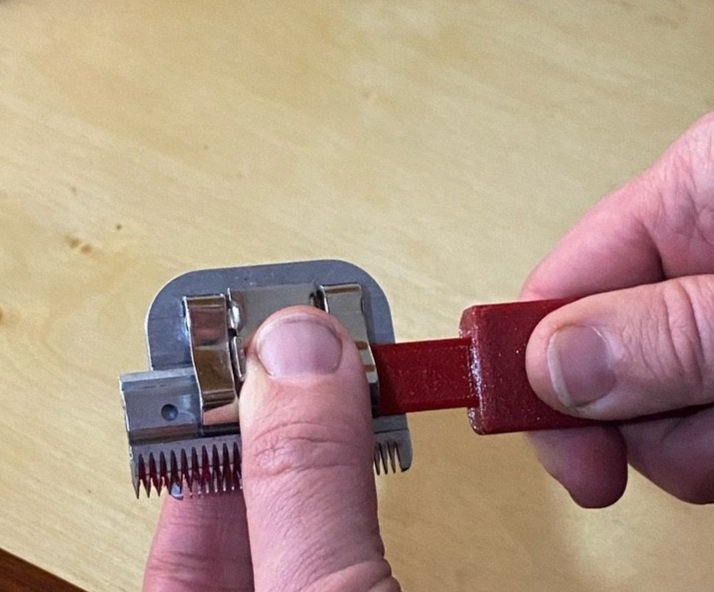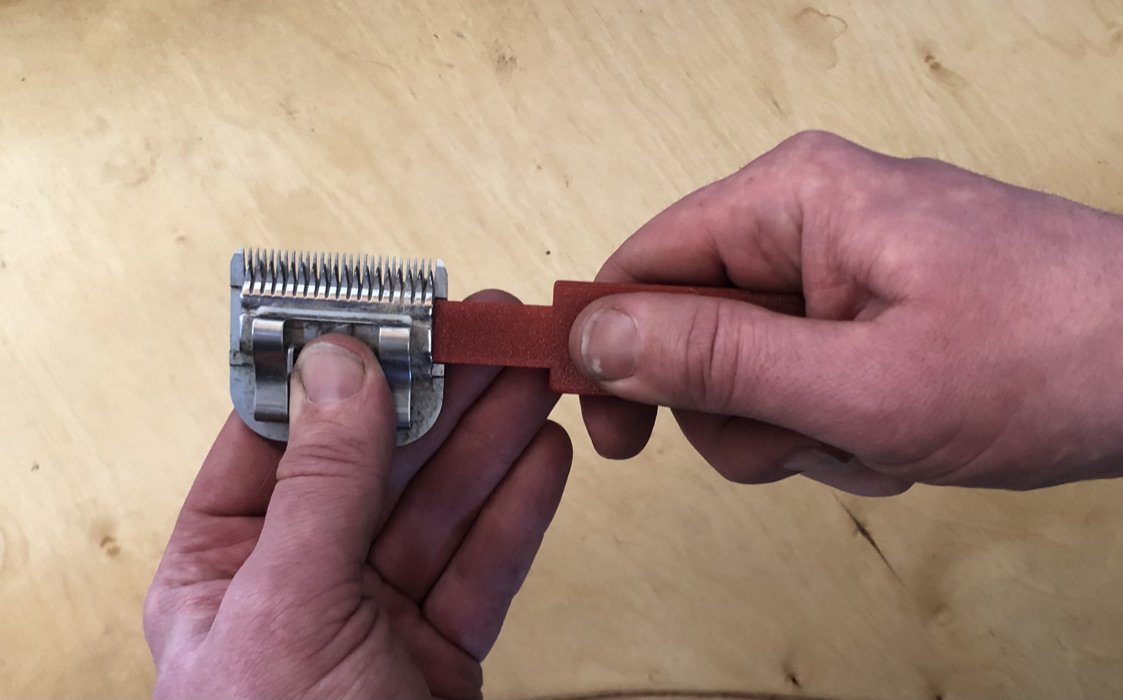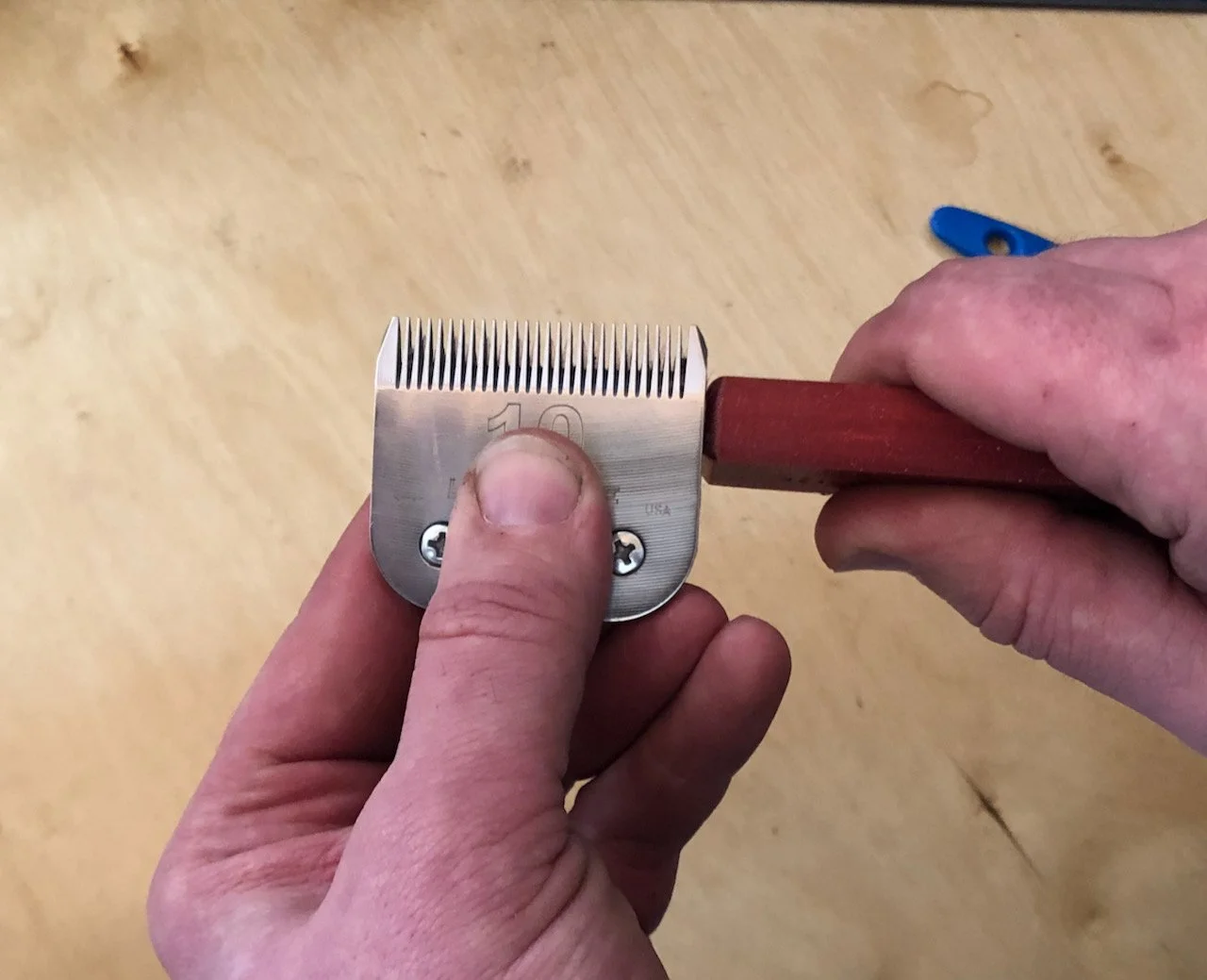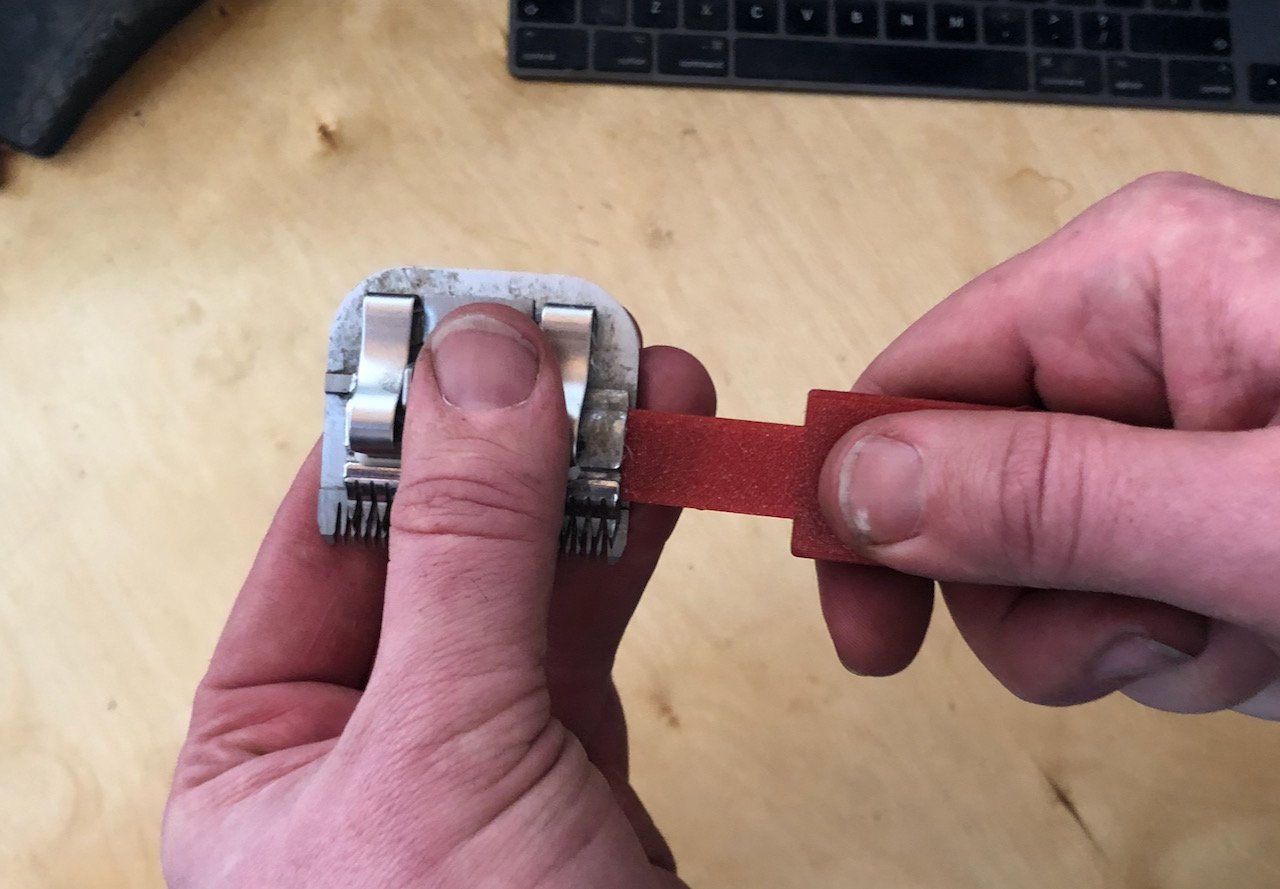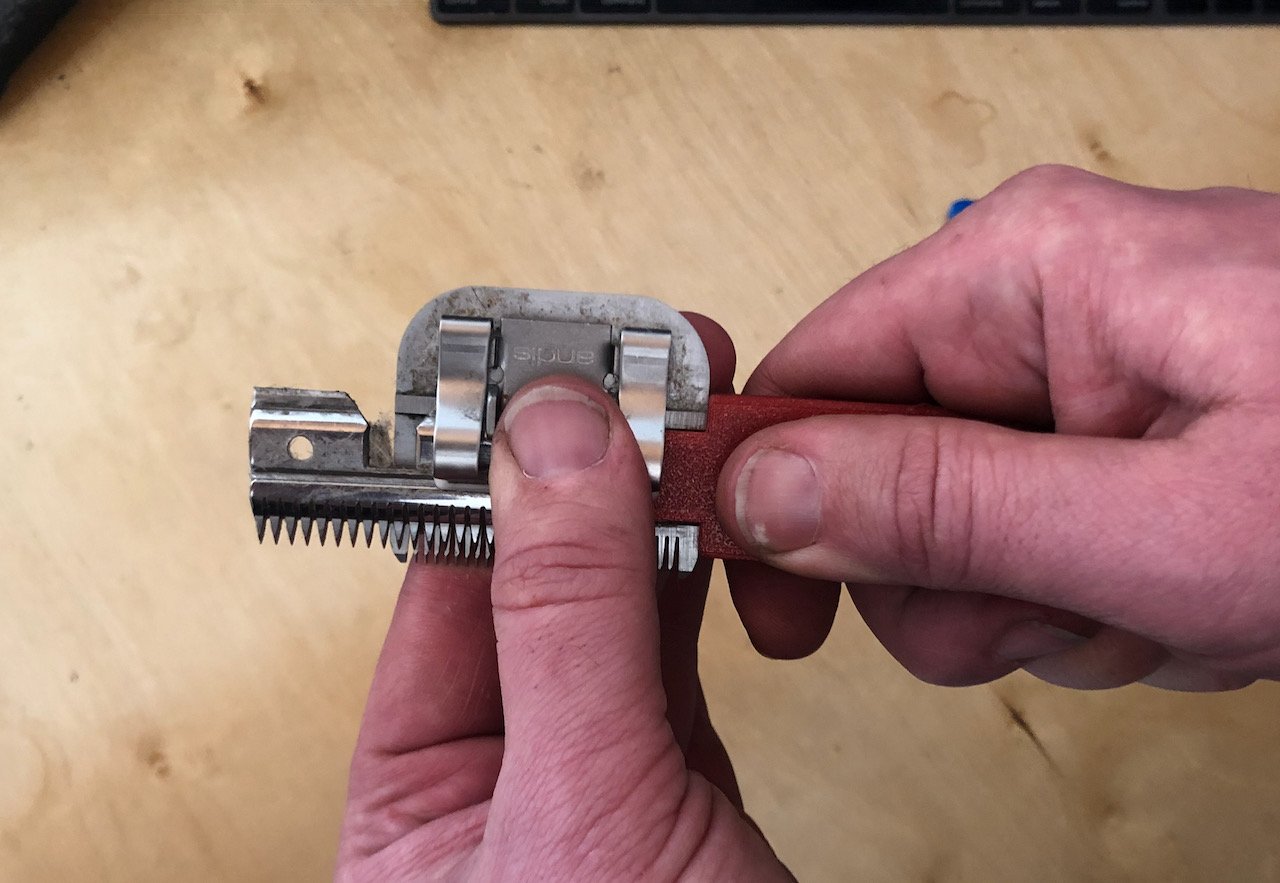Groomers blade push
The background
As a sharpener I deal with groomers regularly and one of them had a re-occurring problem where her blades where coming apart. As someone who is newish to sharpening I was concerned it was something I was doing so a further investigation was needed.
So popped up to her salon where I met one of her clients and after establishing I didn’t in fact have any dog treats. We discussed how her blades where coming apart.
For cleaning them she’s pushing the cutter halfway across the blade so the back of the cutter can be cleaned as well cleaning the comb under the cutter. As the cutters suffer from a great deal of stiction they need a lot of force to get them moving which makes it quite easy to push them straight out the side of the tensioner. There is also the issue that can be difficult to get a decent grip on the cutter.
I left there with a few ideas on how to achieve this.
One idea being a carrier that clipped onto the blade that would limit the distance the cutter could move. This wouldn’t really solve the issue of gripping the cutter. So this would need a push stick.
If I am making a push stick then why not design the push stick so that I can only push so far.
I came up with a reasonably simple design which is easily printed on a 3D printer. Printed out a prototype which I discovered wasn’t screamingly obvious on how to use so I made minor alteration. I then made two more one of which was given to the original groomer. The other I thought I would give to another groomer to see if it was of any interest. I posted it in a groomers group on Facebook and I received much more interest than I expected.
As I have just started up a 3D printing arm of barras blades to try and pay for my hobby of 3D printers. Time to order some more 3D printer filament.
I sent out a few more samples to various groomers one of whom had arthritis and she was utterly delighted with it. It made her life alot easier. So I take that was a high point.
The design of Mk1
Skip this if you aren’t a nerd, read on if you are.
So why have I put the blade on the edge and not put it centrally? If it was mounted centrally then it could be used either way up.
3D printing is a process where layers are built up one on top of one another. (further reading) So to print something you have to have a support underneath the layer as you can’t print in mid air. You can use support material but this normally gives a terrible finish so I try to avoid it.
I could get round this problem by printing the blade push standing on its end and then i could easily print the blade in the middle.
But there is another factor is each layer is quite strong but the amount of strength that joins each layer together is significantly less. It is somewhat like wood as in there is a strong direction and a weak direction. This has to be accounted for when designing something.
If you look to the picture to the right you will see a screen shot from the 3D printing slicing software which shows the layers. The one at the back is printed standing up. If I printed the blade push standing up then it would be very weak and would snap off with clumsy use.
There is a 3rd minor factor related to strength. So while i could use support material to lift the blade up to the centre of the handle it would move it away from the bottom layers. Because most 3D prints are hollow with a light infill pattern inside this would mean the blade would end up hanging off this infill material. There is a few tricks that can be done with modifiers to increase the infill at one end up still ultimately a central mounted blade would still be hanging off infill instead of the stronger bottom layer.
By putting the blade on the bottom surface I can avoid alot of these issues
The next question is material choice
The vast majority of 3D printing is done with PLA. It is easy to print, gives a good finish and comes in a squillion different colours. It is also one of the strongest materials in tensile loading. The downside in this application is it is quite brittle and it isn’t the best at handling heat. The brittle being the killer.
The best material i have on hand for printing this would be Polycarbonate which is the same stuff bullet proof windows are made of it is a very impressive plastic. However its a sod to print unless you go for the carbon fibre filled version which has a few downsides. It’s hard to get and it’s expensive. Even worse for groomers the carbonfibre filled version comes in grey, grey or grey. Groomers don’t like grey. Two of the initial prototypes where printed in this material. So if you have a grey one in your hand. It was printed from some quite expensive material.
This brings me to my material of choice which is PETG which is a glycol modified version of PET which is the stuff coke bottles are made of. I could go into the chemistry but it would be deeply dull and I only have a brief grasp of chemistry.
PETG has advantages over PLA in it is more ductile (bendy) as well as a better high temperature performance so it will survive a brief encounter with a hairdryer or hot water. It is reasonably easy to print and for groomers it comes in a wide range of colours.
I buy mine from Prusa and the range of colours is here If you see a colour there you really like then drop me a line and we can work something out
Late January 2022
The Mk2 design
Well that’s the first lie its more sort of a Mk7 or 8
It is now mid March 2022 and the groomer blade push is doing nicely with it being sent to many many people. I am sure I have given away as many as I have sold. Notable moments being a grooming instructor who initially was somewhat sceptical about the product, so I sent him a free one and now he wants some to show to his students. There is also a reasonably famous groomer who is very impressed with them but i am keeping their name under wraps at the moment. I also took a pile with me to Crufts 2022 and handed them out to many folk.
The intrest has led me to look more seriously into an injection mould. The Mk1 isn’t suitable for injection moulding and it has a few compromises for 3D printing. This would result in a new design copying the basic concept. The mould would cost about £4000 including VAT. Which is a bit of a stinger. The surprise was the unit cost for low production numbers not including the mould isn’t too far off the cost of the 3D printed version. So the injection moulded version isn’t off the table but I have todo alot more research into it as well as marketing them to various grooming supply companies as I don’t have the same reach as Christies. So watch this space I will be reasonably open about the process in the blog but I won’t be giving away too many details.
Which leads us onto the Mk2. Despite the massive THUMB HERE hint on the Mk1 many people did use it the wrong way up. While this isn’t a massive problem it did slightly bother me as using it the wrong way up did increase the chance of the cutter popping out. To solve the wrong way up problem I would need to move the blade part of the blade push up from the bottom of the blade push so that either way up there is a stop against the side of the comb of the blade.
If you have read the above you will know why this isn’t an easy move.
The first problem being the need for support material which I have never been a huge fan of as it leaves bit of a mess underneath but apparently prusaslicer 2.4 is alot better for supports. So I gave it a go and yep it is alot better.
However as i assumed it is quite a delicate end product with not much pressure being needed to break the blade off when compared to the Mk1
This problem is a bit trickier to deal with which is when the blade section is coming from the middle of a perimeter it isn’t as strong as I would like. With 3D printing you can do things that can’t be done with any other form of manufacture. One of these is making hollows inside an object which are sealed. The hollow has side walls which give strength to the end wall. Using this along with a few tweaks using modifier meshes I have made it so most of the time the blade is almost as strong as the Mk1 design. Of course i didn’t get this right first time around and it needed numerous tweaks to the internals and the modifier meshes.
Seeing that the wrong way up problem has been vaguely solved then I can also drop the THUMB HERE text on the bottom. This speeds up printing marginally as well as making the first layer less likely to go wrong.
Mk1 vs Mk2
The mark 1 is still an excellent product which has been warmly received by anyone who has got one so if you have a Mk1 then don’t worry if you use the Mk1 correctly it is exactly the same as a Mk2. the Mk2 is slight comfier to hold but only marginally so. I may produce a Mk1.5 which has the good points of both designs, maybe. Ask me if you want one.
Topside
The blue one is the mark 1, the red one is a mark 2
The Mk2 is slightly lower and has a more rounded back end. This makes it nice to hold and makes it slightly more suitable for an injection moulded product
You can also just see the blade of the mk2 is above the desk
Bottom
This is where the major differences are. The Mk2 by having the blade away from the bottom of the handle means that there is a stop what ever way up the blade push is held
The problem
As the blade of the blade push is flush with the bottom if you use it the wrong way up then it is normally stopped by the two rails on the comb. But if your rails are almost gone or you are heavy handed then it is possible to push the cutter across further than designed.
It isn’t a major issue as the blade push isn’t long enough to push the cutter out from under the tension spring but it isn’t quite as secure.
The solution
The step on the mk2 means it is almost impossible for you to push the cutter too far. Even when you use it the wrong way up.
But I am sure someone will manage to push it too far.
Now the Mk2 isn’t perfect and it is marginally weaker than a Mk1. But i will include a 12 month warranty on them so if you break it then send me a picture and i will stick one out in the post for you.
How to use
I’m going to assume you already have some dirty clipper blades which is the most vital part of the operation.
What you will also need is at least a brush for cleaning. I use a small toothbrush sized brass brush for most of the cleaning I do while sharpening. Link here. Other options are a paint brush, an actual toothbrush or even a mini air compressor.
After cleaning you are going to want to re-oil the blade. If you haven’t got one then you want a “needle point oil dispenser” These come in many sizes and flavours but you probably want at most a 50ml one with 30ml being a nicer size to use.
For more blade care info head over here
The pictures below are all of the Mk1 blade push and in use the Mk1 and the Mk2 are identical. So I haven’t changed the instructions for the Mk2
However the Mk2 still has a better way to hold it.
This way the text is down. So the rounded face is in you fingers and your thumb is on the big flat bit.
I find this a more comfortable way to hold it.
This isn’t the wrong way to hold it but it certainly is the uncomfortable way to hold it,
The corners of the flat face dig into your fingers
Step 1
Line up the blade of the blade push with the cutter on your blade. Keep it between the two shiny bits (rails and teeth)
And with your other hand hold the blade by the blade socket.
You can hold it the other way around for the left handed out there
Step 2
Push the cutter across until the blade push comes against the side of the comb.
This should allow you enough room to get to the back of the cutter and the comb.
Step 3
Brush away the hair or whatever is hiding under there
Step 4
Flip the blade over and clean under the cutter. This is a good time to oil the blade with a small drop of oil on the shiny bits
Step 5
Turn the blade push around and using the back of it against the cutter
Step 6
Push the cutter home using the back of the blade push
Step 7
Now flip your clipper blade with the teeth towards you and hold it by the back. Then as per step 1 line the end of the blade with the cutter between the two shiny rails.
Step 8
Push the blade across until the blade push hits the side of the comb.
Then clean and lube as above
If you like the blade push then it can be purchased from my online shop HERE
